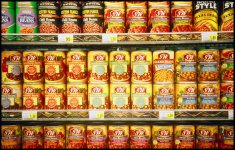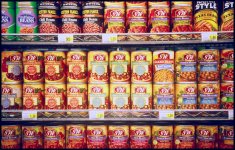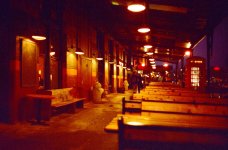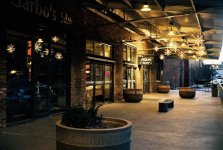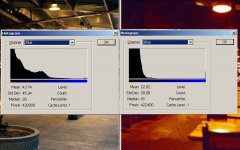like2fiddle said:
I must be doing something wrong. I have dreadful results when using this film indoors unless it is during the daytime with ample natural light.
Let me see if I can summarize the goings-on from early 2006 when I learned why this works, and excuse me for a long and motormouthy diatribe here ...
To make a long story long ...
I found the hard way a couple of times that the Walgreens/Agfa 400 and 800 films don't work well in available or mixed light.
The first two images below are taken under similar light and only a couple blocks from each other. This is grey twilight and incandescent/mixed lights from the businesses.
The first image was when I tried out the Walgreens/Agfa 400 for available light. I always had good luck with Fuji films for low/available light and was trying this out, hoping for similar results. I could not adjust the levels to get a normal looking image at all. I posted it here and also asked on APUG and a couple smaller boards.
A couple guys who were very much into the geeky techie spectral response diagnosed it as a weak (underexposed) blue layer in the film, and recommended that I shoot some similar scenes with Fuji and compare. The second one is just that.
If you look at the third image, the blue histograms of both, you'll see that for the Agfa, the information is all scrunched up over to the left (dark) side. For Fuji, although it's not perfect, it records far much more of the blues that were present, and gives a more normal print.
The way it was explained to me was that this "4th color layer" gives more of an even response under poor lighting situations, in the same way the classic Verichrome Pan, with two emulsion coatings of different sensitivity made the film very tolerant of poor exposure.
The Agfa film is apparently daylight balanced and only intended for daylight or daylight equivalent, while the Fuji is able to take a joke, so to speak, and give you a more normal appearance under incandescent, or more realistically, a mixed light situation.
Anyway, a slight digression which I did remember from my very young years. Apparently in about 1960, Kodak changed the balance of their Kodacolor film from straight daylight to kind of between daylight and the clear flash of those days, making the film usable for both.
When I was very young I always remember that Dad used clear flash for B&W and blue flash for color, so when I went to buy my very first roll of color film for my Brownie Starflash, I also picked out a package of blue blubs. The druggist then corrected me (this was back when shop employees actually knew things about what they were selling) and pointed out that the new Kodacolor was used with CLEAR flash. I do remember the boxes of 1960s vintage Kodacolor as saying "Daylight or clear flash" on them.
Anyway, that's my experience with this kind of thing. I use the Fuji films almost exclusively for low-light or available light work now. I can give several more examples of this if you want.


